Dodecatheon
|
Family: Primulaceae |
Herbs perennial, not cushion- or mat-forming. Rhizomes (or caudices) usually present; roots fibrous, bulblets sometimes present. Stems (scapes) erect or nearly so, simple. Leaves in basal rosettes, simple; petiole ± winged, (sometimes sheathing); blade linear to oval, base abruptly or gradually tapering to petiole, margins entire, dentate, or crenulate, (sometimes undulate), apex mostly acute to rounded, surfaces glabrous or glandular-pubescent or -puberulent. Inflorescences usually umbels, 2-25(-125)-flowered, sometimes solitary flowers; bracts usually ternate. Pedicels recurved, usually straight and longer in fruit. Flowers homostylous; sepals 4-5, usually green, calyx tubular, not keeled, glabrous or minutely glandular, lobes spreading to reflexed, usually longer than tube; petals 4-5, white to pink or violet, or magenta to purple with yellowish and/or whitish base, often with purple, maroon, or reddish ring, corolla short-tubular, lobes strongly reflexed, length 2+ times tube, apex mostly acute; stamens ± exserted; filaments distinct or ± connate, forming tube; anthers connivent. Capsules cylindric, dehiscence valvate or operculate and lid opening as 5(-10+) toothlike segments. Seeds 50-200, dark brown to black, globose to ovoid or quadrate, sometimes with thin, membranous margins, irregularly alveolate, alveolae formed by collapse of minute bulbous cells. x = 22. Members of Dodecatheon are widespread throughout much of North America, extending from northwestern Mexico to the Arctic in Alaska and northwestern Canada. Taxonomic boundaries between species are sometimes blurred, and the variation within the more widespread species (such as the eastern D. meadia and the western D. pulchellum) can be bewildering. Nearly all recognized species have an array of synonyms, and some names used in the past have proven to be illegitimate or misapplied, adding to the nomenclatural morass. The genus can be subdivided into two groups (but not the three recognized by H. J. Thompson 1953), based primarily on the rugose (sect. Purpureo-tubulosa R. Knuth) versus smooth (sect. Dodecatheon) anther connective (A. R. Mast et al. 2004). Species with an enlarged stigma (notably Dodecatheon jeffreyi, the type of sect. Capitata H. J. Thompson) fall into the latter taxon. Even so, as noted in the key, both D. hendersonii and D. subalpinum occasionally have smooth connectives, and D. poeticum, a member of sect. Dodecatheon, has rugose connectives.
PLANT: Perennials with upright stems. LEAVES: basal, glabrous or nearly so in ours; margins various. INFLORESCENCE: a scapose umbel. FLOWERS: white or pink to purple or magenta and generally with a yellow tube, drooping; calyx deeply lobed, the lobes 4-5; corolla deeply lobed, the 4-5 lobes and part of the tube reflexed, the apices acute to obtuse; stamens 4-5, the filaments generally united; ovary superior. FRUITS: generally valvate. NOTES: Ca. 14 spp., generally of N. Amer. (Greek: twelve gods). Thompson, H. J. 1953. Contr. Dudley Herb. 4:73-154. REFERENCES: Cholewa Anita F. 1992. Primulaceae. Ariz.-Nev. Acad. Sci. 26(1)2 Cal deeply parted, persistent; cor cleft almost to the base, its lobes reflexed; filaments very short, ±connate; anthers elongate, erect, connivent; style about equaling the anthers; capsule opening by 5 short terminal valves; glabrous perennials with a basal rosette of lvs, erect scapes, and a terminal, bracteate umbel of handsome nodding fls on ascending or erect pedicels; fr erect. 13, N. Amer. Gleason, Henry A. & Cronquist, Arthur J. 1991. Manual of vascular plants of northeastern United States and adjacent Canada. lxxv + 910 pp. ©The New York Botanical Garden. All rights reserved. Used by permission. |

